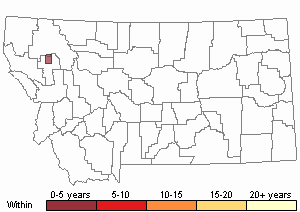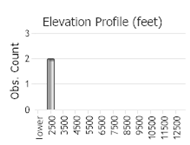View in other NatureServe Network Field Guides
NatureServe
Montana
Utah
Wyoming
Idaho
Wisconsin
British Columbia
South Carolina
Yukon
California
New York
Chinese Mysterysnail - Cipangopaludina chinensis
Other Names:
Bellamya chinensis
State Rank Reason (see State Rank above)
A conservation status rank is not applicable because this species is not a suitable target for conservation activities as a result of being exotic or introduced and is not known to occur in Montana.
General Description
The Chinese Mysterysnail is a large (2-3 inches, 65mm tall) introduced snail in the genus Cipangopaludina which can be identified by their relatively large globose shells and concentrically marked opercula (Burch 1980). Cipangopaludina chinensis has a width to height ratio of 0.74–0.82, the shell has 6.0–7.0 whorls, and the inner coloration is white to pale blue (Clarke 1981, Jokinen 1992). This species has a small and round umbilicus and the spire is produced at an angle of 65–80º (Jokinen 1992). Cipangopaludina chinensis exhibits light coloration as a juvenile and olive green, greenish brown, brown or reddish brown pigmentation as an adult (Clarke 1981, Jokinen 1992). In juveniles, the last shell whorl displays a distinct carina, and the shell contains grooves with 20 striae/mm between each groove (Clarke 1981, Smith 2000).
Diagnostic Characteristics
The large size and width of the adult shell makes it unlikely to be confused with any native snails in Montana. Cipangopaludina chinensis exhibits light coloration as a juvenile and olive green, greenish brown, brown or reddish brown pigmentation as an adult (Clarke 1981, Jokinen 1992). In juveniles, the last shell whorl displays a distinct carina, and the shell contains grooves with 20 striae/mm between each groove (Clarke 1981, Smith 2000).
Range Comments
Native Range: Southeast Asia to Japan and eastern Russia.
Introduced in the Great Lakes Region: The first record of C. chinensis in the Great Lakes dates from some time between 1931 and 1942 from the Niagara River, which flows into Lake Ontario (Mills et al. 1993). Cipangopaludina chinensis occurs in Lake Erie, where it was introduced some time prior to 1968 (Wolfert and Hiltunen 1968). Cipangopaludina chinensis was found for the first time in Oneida Lake, which flows to Lake Ontario, in 1977-1978 (Clarke 1978, Jokinen 1992). Jokinen (1982) records occurrences of populations of C. chinensis in the drainages of Lake Erie, Lake Ontario and Lake Michigan, from the states of Michigan, Indiana, Ohio, Wisconsin, and New York.
For maps and other distributional information on non-native species see:
Nonindigenous Aquatic Species Database from the U.S. Geological Survey
Invasive Species Habitat Tool (INHABIT) from the U.S. Geological Survey
Invasive Species Compendium from the Centre for Agriculture and Bioscience International (CABI)
EDDMapS Species Information EDDMapS Species Information
Observations in Montana Natural Heritage Program Database
Number of Observations: 5
(Click on the following maps and charts to see full sized version)
Map Help and Descriptions
Relative Density

Recency



 (Observations spanning multiple months or years are excluded from time charts)
(Observations spanning multiple months or years are excluded from time charts)
Habitat
Prefers slow-moving freshwater rivers, streams, and lakes with soft, muddy or silty bottoms (Kipp et al 2017).
Food Habits
Cipangopaludina chinensis feeds on organic and inorganic bottom material as well as benthic and epiphytic algae, mostly by scraping, but diatoms are probably the most nutritious food it ingests at pond sites in eastern North America (Jokinen 1982).
Ecology
This species has been found in waters in eastern North America with pH 6.5–8.4, calcium concentration of 5–97 ppm, magnesium concentration of 13–31 ppm, oxygen concentration of 7–11 ppm, depths of 0.2–3 m, conductivity of 63–400 µmhos/cm, and sodium concentration of 2–49 ppm (Jokinen 1982, Jokinen 1992, Stanczykowska et al. 1971). This species has not caused serious impacts in the Great Lakes, and is considered relatively “benign” with respect to its potential to greatly change or influence ecosystems and native species (Mackie 1996).
Reproductive Characteristics
This species is ovoviviparous (Jokinen 1992). Females live up to 5 years, while males live up to 3-4 years (Jokinen 1982, Jokinen 1992). Female fecundity is usually greater than 169 young in a life time, and may reach up to 102 for any given brood (Jokinen 1982). All females generally contain embryos from May to August and young are born from June through October in eastern North America in shallow water, then females begin migrating to deeper water for the winter in the fall (Jokinen 1982, Jokinen 1992, Stanczykowska et al. 1971). Females bear more young in their 4th and 5th years than in other years (Jokinen 1992).
Management
Stewardship Responsibility
Threats or Limiting Factors
Because the mysterysnail prefers slow-moving rivers, streams, and lakes with soft, muddy or silty bottoms, this species would not survive introduction into most of Montana's cold-water trout rivers and would likely only become established in ponds or lakes.
References
- Web Search Engines for Articles on "Chinese Mysterysnail"
- Additional Sources of Information Related to "Snails / Slugs"





